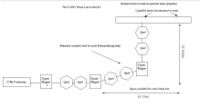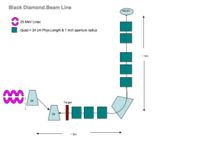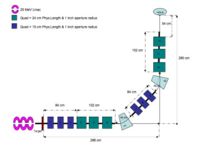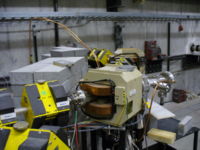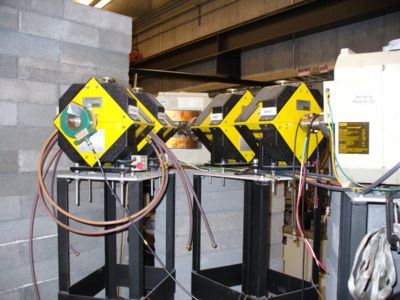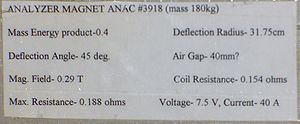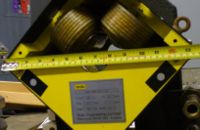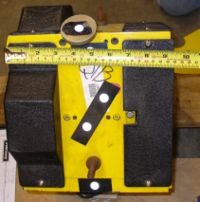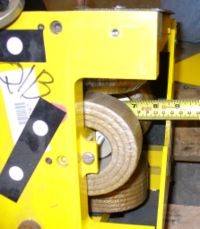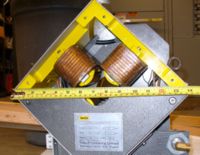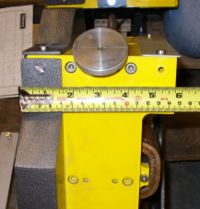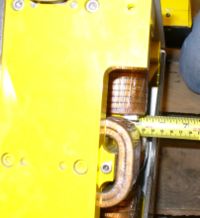Difference between revisions of "IAC positron beamline"
| Line 130: | Line 130: | ||
==Parts needed== | ==Parts needed== | ||
| + | #target ladder (in/out) | ||
#beam line | #beam line | ||
#dipole magnet | #dipole magnet | ||
Revision as of 16:59, 11 January 2008
Below are three possible configurations for a positron beam line at the IAC. They are listed in order of increasing complexity and difficulty. Because of the recent winter storm, they are code named using ski trail nomenclature.
Configuration 1: "Green run"
This configuration is expected to require the minimal amount of effort (3 days) and is to be used as a "test of principle" in order to justify further investment.
The "Green run" configuration proposes switching only two beamline elements. There are three elements between the last two Dipole magnets (D2 & D3) in the beam line. The first element, after a 45 degree bending magnet(D2), is the first quadrupole magnet of a doublet pair. The quadrupole is followed by a quad port for mounting targets and then the second half of the quad doublet just before entering the last 45 degree dipole bending magnet(D3).
The "Green run" configuration would have the first quad of the quad doublet and the target port switch places in the beam line. The target (a Tungsten converter to produce positrons) would be placed just after the first 45 degree dipole. The quad doublet would be positioned after the target and before the last 45 degree bending dipole magnet(D3).
changes
- switch target mount assembly (4-way cross) and quadrupole (3 days)
Goals
The goal of this configuration will be to test positron production efficiencies and determine if the results are scalable by improving the beam line optics.
Sketched (not to scale) layout of the 25 MeV beamline:
296 cm = parrallel Distance From the end of the accelerator module (After RF cavities) to experimental cell port
280 cm = Distance From accelerator zero degree beamline to Experimental Cell Wall
56 cm = distance between flanges for the first dipole
84 cm = distance between flanges for the first quad doublet
This configuration looses a lot of positrons due to dispersion before
Configuration 2: " Blue run"
This configuration is expected to require a modest amount of effort (1 week) and is to be used as an improved "test of principle" in order to justify further investment.
The "Blue run" configuration would have the positron converter target positioned as describe above in the "Green run" but it would replace the quad doublet with a thin Quad triplet.
changes
- maching new spool pieces
- install control system for the additional quadrupole
- recondition thin quadrupoles to be more water leak resistant and more easily maintained.
Goals
The goals of this configuration would be similar to the "Green run"
Configuration 3: " Black Diamond"
This configuration builds a new beam line which will use the first dipole (D0) currently in place to deflect electrons at 45 degrees beam left. Dipole "D3" will take out the 45 degree deflection of D0 and then send electrons to a 90 degree dipole which will then direct the electrons to the experimental cell through dipole D2 which has been turned off.
A rough measurement suggests that this set up will have as much space as Configuration 4 below, if not more.
Sketched (not to scale) layout of the 25 MeV beamline:
Configuration 4: "Double Black Diamond"
This configuration would require a substantial amount of effort (3 weeks) and would be used as a performance test to determine the maximum positron yield from the 25 MeV linac at the IAC.
changes
- replace the first dipole with 6 quadrupoles
- replace the first 45 degree bending dipole with one that can bend the beam by 45 degree either beam left or beam right. (this will allow us keep the configuration in place and continue experiments which required the first dipole that was removed)
- replace the quad doublet between the last two dipoles with a quad triplet
- install a control system for all the new magnets
Criticisms/problems to solve
- There is not enough room for the target following by 6 quadrupoles. Without the target, quadrupoles 1-6 would occupy 1" more space than what exists. Moving the linac to make space is not a desirable option.
- A magnet to replace the second dipole which would bend the beam +/- 45 degrees as well as allow the beam to pass undeflected would need to be procured
- Additional power supplies for quads 1-6 may need to be procured.
- The thin quadrupoles are difficult to maintain. Specifically, new fittings for the cooling lines would need to be installed which would ease maintenance.
- the proposed beam line changes would require a level of effort similar to moving the Linac in order to fit additional optics elements between the last dipole and the wall
Goal
A complete test of the optimal positron production capabilities using the 25 MeV Linac machine.
Proposed beam line
the above would produce a 1 cm diameter positron beam spot just in front of the wall to the experimental cell.
The mean positron energy would be 2-3 MeV and is tunable.
Magnet pictures
This picture shows you the current 90 degree bend into the experimental hall. Quad 1 and Quad 2 are shown and then the 2nd Dipole magnet (labeled Bending Magnet 2A a.k.a. Dipole 2) begins after Quad 1 and Quad 2. Dipole 2 is following by another Quad doublet and then a Dipole (Dipole 3) and then a final quad doublet before going through the wall into the experimental cell.
Length of Iron =
Diameter of Coils=
The next picture was taken upstream of the 90 degree bend and shows Dipole 1 which is usually off unless we want to bend beam right into the accelerator hall instead of going straight to Quad 1 and Quad 2.
Label on side of Dipole 1
Label on side of Dipole 2
The Quad doublets in the current beam line have the following label.
Quad doublet size:
We also have Quad triplet which take up less space than the doubles.
Task List
Parts needed
- target ladder (in/out)
- beam line
- dipole magnet
- OTR
- separate power supply for dipole d2 needs to be installed
- NAI: it fits into the pipe through the wall.
Part in hand
- 1 mm thick tungsten target into cube
- 2 drift chambers
- 2, 1 cm x 2 cm scintillators
- 2, 8 cm x 20 cm scintillators
- 1mm & 2mm thick Tungsten targets
- FC: pico ammeter (100 micro amps to 1 mA)
- Yag scintillatorin viewer(0.1 mRad/hr on contact, 0.06 mRad/hr at 30 cm.) 100 micron thick crystal
CHIP collaboration meeting Notes 1-11-08
- MOU: Advertizement, talk at Idaho or JLBA, teleconferencing, Joint or Bridge.
Optics
5% of the created positrons would be accepted off the target and need to be transported.
